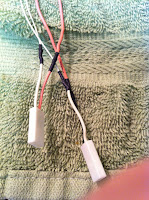Once the new screen arrived, I got right to work on DVI solder prep. To start, I removed the shrink wrap holding the two video wires together and used a pocket knife blade to carefully fold back and remove the thin metal housing.
Then I used the same blade to pry up the plastic tabs on the connector and free the little golden cable ends.
Because the DVI Cable is so large in comparison to the hole at the top of the iMac's dome, it's necessary to feed the neck wires into the dome and reattach it to the neck. If you use the two
black screws, you won't have to use the white plastic cap that will force each of the four wires off in a different direction and shorten the amount of cable you have to work with. Just make sure you skip one screw hole so you can fit the white plastic cap back over the top when you're done.
 |
| Pinout for a standard DVI cable. |
Then I got to soldering. For the most part, everything went really smoothly. However, there were a few peculiar things.
I talked in my last post about the shield wires and how they correspond with the shield wires in the neck by not having any insulation on them.
Well, because this is only a 17" monitor, it only uses 3 of the 6 possible TDMS data triplets (pair of wires + shield). The first three coincide perfectly with the
red,
light blue &
dark blue triplets.
 |
JBerg's Pinout of the 17" iMac's screen
(note: There are two possible configurations.
This is mine. See JBerg's blog post for more info) |
|
But the
final triplet (marked on JBerg's pinout as RxC and on the generic pinout as TMDS Clock, presumably the same thing) uses the DVI Pins 22, 23, 24 which are correct as far as the pinouts go, but not from what is actually showing up on the connector.
On the connector, the
shield wire (Pin 22) is not looking like the rest of the
shield wires on the cable, even though it's being connected to a standard looking shield wire from the iMac's cable.
And then,
pin 24 (the TMDS Clock -) wasn't even a wire on the cable. I had to pull another wire from the cable that wasn't being used and solder it to the connector. That was very strange.
So I finished the DVI cable, fallowing the pinouts above.
For the power cables (grey, green, blue purple, yellow & orange), I rigged up a detachable connection using the connector from the iMac's inverter and some little pins. I attached the three positives (purple, yellow & orange) and three grounds (grey, blue & green) to the connector end. On the other side, I jury rigged some pins and attached them to a 5V @ 1 amp AC wall adapter.
At this point, I had the DVI cable all made up and ready to go. I figured I'd give it a shot without bothering with the backlights, just to see if it worked. Of course, it didn't. Holding a flashlight up to the screen, there wasn't a hint of an image.
The only promising thing was the my MacBook's screen went blue for a second as it does when you connect it to an external monitor, but when it came back, it didn't give any hint of an external display... :-/
Time to call it a night though.















































